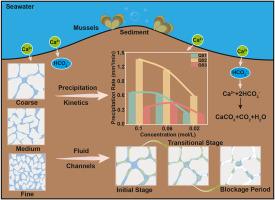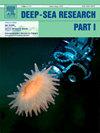深海冷渗环境多孔介质中碳酸盐沉淀特征的x射线CT成像
IF 2.1
3区 地球科学
Q2 OCEANOGRAPHY
Deep-Sea Research Part I-Oceanographic Research Papers
Pub Date : 2025-07-24
DOI:10.1016/j.dsr.2025.104556
引用次数: 0
摘要
阐明冷渗碳酸盐的发育过程对理解冷渗生态系统甲烷循环的演化动力学至关重要。冷渗碳酸盐是甲烷厌氧氧化的产物,在调节海洋碳循环中起着重要作用。然而,驱动碳酸盐沉淀的机制仍然知之甚少。本研究采用x射线计算机断层扫描技术,在深海冷渗环境中观察孔隙尺度(μm)上碳酸氢盐离子浓度和沉积层动力学。结果表明:在流体过饱和的驱动下,碳酸盐沉积在砂柱底部以慢速流动和溶质堆积为主,从而产生空间非均质性;其中,在420 ~ 600 μm的中颗粒体系和0.06 mol/L的碳酸氢盐浓度条件下,沉淀速率为1.36 mm3/min。沉淀过程遵循局部堵塞机制,这反过来又降低了相对于孔隙率的导水率。此外,流体流动性的差异导致流体流动网络的重新配置,最终促使横向迁移和新流动模式的形成。这些发现为碳酸盐的形成机制、碳酸盐动力学和海洋生物固碳过程提供了重要的见解。本文章由计算机程序翻译,如有差异,请以英文原文为准。

Carbonate precipitation characteristics in porous media of deep-sea cold seep environment by X-ray CT imaging
Elucidating the developmental processes of cold-seep carbonates is essential for understanding the evolutionary dynamics of methane cycling in cold-seep ecosystems. Cold-seep carbonates, as products of anaerobic methane oxidation, play an important role in regulating the oceanic carbon cycle. However, the mechanisms driving carbonate precipitation remain poorly understood. This study employs X-ray computed tomography to visualize bicarbonate ion concentration and sedimentary layer dynamics at pore scales (μm) in a deep-sea cold-seep environment. The results reveal that carbonate precipitation, driven by fluid supersaturation, is preferentially promoted at the sand column base by slower flow and solute accumulation, thereby generating spatial heterogeneity. Specifically, the optimal precipitation rate of 1.36 mm3/min occurs under conditions of the 420−600 μm medium-particle system and 0.06 mol/L bicarbonate concentration. The precipitation process follows a localized clogging mechanism, which in turn reduces hydraulic conductivity nonlinearly relative to porosity. Furthermore, differences in fluid mobility induce reconfigurations in fluid flow networks, ultimately prompting lateral migration and the formation of novel flow patterns. These findings provide crucial insights into carbonate formation mechanisms of, carbonate kinetics, and marine biological carbon sequestration processes.
求助全文
通过发布文献求助,成功后即可免费获取论文全文。
去求助
来源期刊
CiteScore
4.60
自引率
4.20%
发文量
144
审稿时长
18.3 weeks
期刊介绍:
Deep-Sea Research Part I: Oceanographic Research Papers is devoted to the publication of the results of original scientific research, including theoretical work of evident oceanographic applicability; and the solution of instrumental or methodological problems with evidence of successful use. The journal is distinguished by its interdisciplinary nature and its breadth, covering the geological, physical, chemical and biological aspects of the ocean and its boundaries with the sea floor and the atmosphere. In addition to regular "Research Papers" and "Instruments and Methods" papers, briefer communications may be published as "Notes". Supplemental matter, such as extensive data tables or graphs and multimedia content, may be published as electronic appendices.

 求助内容:
求助内容: 应助结果提醒方式:
应助结果提醒方式:


